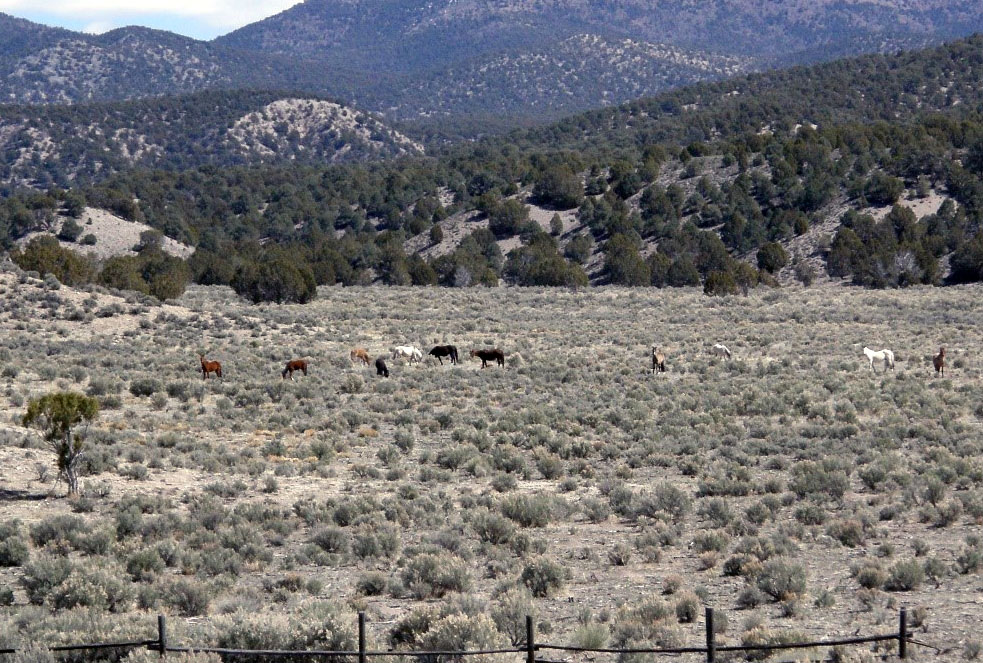BLM to conduct Eagle Complex wild horse gather
Organization:
BLM Office:
Media Contact:
 ELY, Nev. – The Bureau of Land Management’s (BLM) Caliente and Cedar City field offices on or about January 13, 2020 will begin gathering excess wild horses from in and around the Eagle Complex located near Pioche, Nev. The Complex consists of the Chokecherry, Eagle and Mt. Elinor Herd Management Areas (HMAs).
ELY, Nev. – The Bureau of Land Management’s (BLM) Caliente and Cedar City field offices on or about January 13, 2020 will begin gathering excess wild horses from in and around the Eagle Complex located near Pioche, Nev. The Complex consists of the Chokecherry, Eagle and Mt. Elinor Herd Management Areas (HMAs).
The BLM will gather up to 1,700 excess wild horses and remove up to 1,600 excess horses. The BLM will treat up to 50 mares with the fertility control vaccine GonaCon-Equine and release the mares with an equal number of stud horses.
The current population estimate for the Eagle Complex is 2,484 wild horses, including the 2019 foal crop. Appropriate Management Level (AML) is 139-265 wild horses. The purpose of the gather is to prevent undue or unnecessary degradation of the public lands associated with excess wild horses, and to restore a thriving natural ecological balance and multiple-use relationship on public lands, consistent with the provisions of Section 1333(b) of the 1971 Wild Free-Roaming Horses and Burros Act. Removing excess animals would also enable significant progress toward achieving the Standards for Rangeland Health identified by the Mojave-Southern Great Basin Resource Advisory Council.
The BLM Color Country (Utah) and Ely (Nevada) districts will conduct gather operations using the helicopter-assisted method. The Eagle HMA is in the BLM Ely District on public lands administered by the Caliente Field Office. The Chokecherry and Mt. Elinor HMAs are in the Color Country District on public lands administered by the Cedar City Field Office. The gather may also take place in areas outside the HMAs where wild horses have moved in search of food and water. The gather is expected to last approximately six weeks.
The BLM’s priority is to conduct a safe, efficient, and successful wild horse gather operation while ensuring humane care and treatment of all animals gathered. The BLM and its contractors will use the best available science and handling practices for wild horses while meeting overall gather goals and objectives in accordance with the Comprehensive Animal Welfare Policy.
All horses identified for removal will be transported to the Palomino Valley Center Wild Horse and Burro Corrals, in Sparks, Nev., where they will be checked by a veterinarian and readied for the BLM’s wild horse and burro Adoption and Sale Program.
Members of the public are welcome to view the gather operations, provided that doing so does not jeopardize the safety of the animals, staff and observers, or disrupt gather operations. The BLM will escort the public to gather observation sites located on public lands. The BLM anticipates that viewing opportunities will begin on or about January 14, 2020, weather and logistics permitting. Once gather operations have begun, those wanting to view gather operations must call the gather hotline nightly at (775) 861-6700 to receive specific instructions on each days’ meeting location and time.
The BLM is conducting the gather under the DOI-BLM-NV-L030-2018-0004-EA Eagle HMA Gather Plan Environmental Assessment decision signed on August 27, 2018. Access the Decision Record and determination of National Environmental Policy Act adequacy at https://go.usa.gov/xpVZr.
Once the gather is underway, the BLM will post gather reports and additional information on its website at https://go.usa.gov/xpSxK. For technical information, contact Wild Horse and Burro Specialist Ben Noyes at (775) 289-1836 or [email protected].
For information on how to adopt or purchase a wild horse or burro, visit www.blm.gov/whb.
The BLM manages about 245 million acres of public land located primarily in 12 western states, including Alaska, on behalf of the American people. The BLM also administers 700 million acres of sub-surface mineral estate throughout the nation. Our mission is to sustain the health, diversity, and productivity of America’s public lands for the use and enjoyment of present and future generations.
